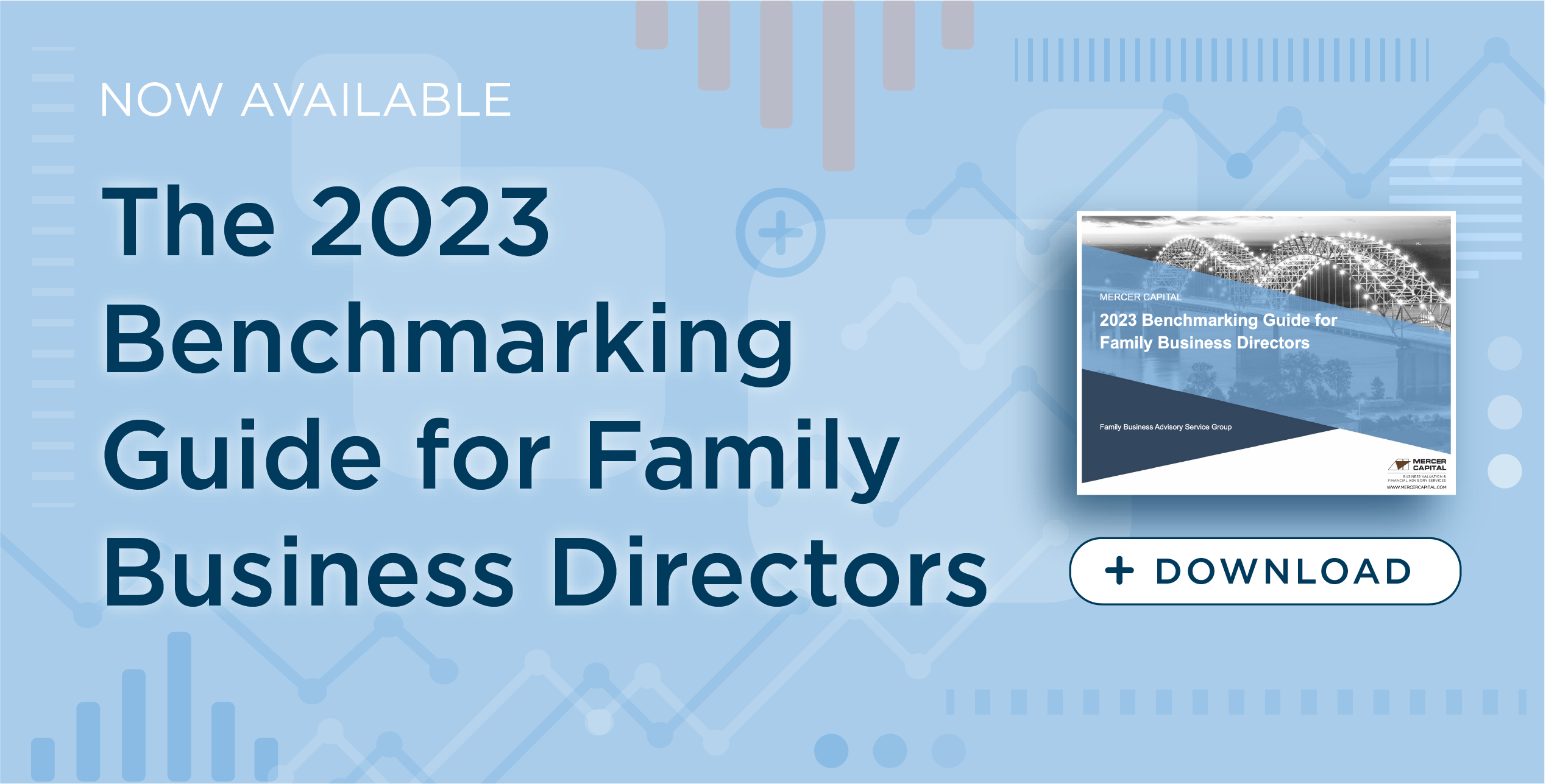Case Study: Second-Generation Shareholders Achieve Long-Term Sustainability
Since 1982, we have been observing and working with successful family companies. Over that period, there aren’t many family business scenarios the professionals at Mercer Capital haven’t seen. We bring that accumulated experience to bear in our assignments advising family businesses. In the following case study, we summarize a recent engagement.
We received a call from a shareholder in a successful, second-generation family business as result of our publications regarding dividend policy. The four second-generation owners had purchased the business from their parents a number of years earlier.
Shareholders had differing views regarding the business, the future outlook, and dividend policy.
The Company was in uncharted territory. The Company had been growing, the acquisition debt was nearly paid off, and the shareholders had differing views regarding the business, the future outlook, and the appropriate dividend policy.
The second-generation owners had done some planning of their own, and the CEO, who had led the first-generation buyout and had run the Company for years, was looking to transition into a board and owner role after bringing on a non-family CEO.
The Engagement
In addition to the three shareholders (each of whom served as directors), the Company had two outside board members with diverse operating and financial experience. So there were two questions for the shareholders and the board, from their differing perspectives.
- What portion of shareholder returns should come from dividends and what portion from expected capital appreciation?
- What dividend policy would be reasonable for the Company, given the development of outside management and the need for and opportunities for the Company to grow?
Mercer Capital was retained to help the shareholders and directors address these questions. The engagement was divided into two phases.
Phase I: Financial Discussion and Education
Understanding the Needs of All Stakeholders
First, we met with the shareholders collectively and individually. The purpose was to understand their differing perspectives regarding future dividends from the business. We also spent time talking about the purpose of dividend policy and the various ways in which it could be implemented in a company like theirs.
As the discussions ensued, it became clear that the four shareholders had differing personal perspectives and had followed differing personal investment plans leading to the current point.
One of the shareholders had built a significant, multi-million dollar investment portfolio based on the small, incremental dividends that had been paid over the years that the Company was repaying acquisition debt to the parents. The other two shareholders had modest portfolios outside the business.
There was a disparity in the level of shareholder liquidity outside the Company. We realized that, given the then-current profitability of the business and the retirement of acquisition debt, the Company had substantial free cash flow and substantial value.
We also met with the board of directors, which included the shareholders and the outside members.
Recommendations to Address Shareholder Liquidity Now and in the Future
In the first meeting, we suggested that it might be reasonable to consider a leveraged dividend recapitalization. The purpose of the recapitalization was to provide a substantial, after-tax nest egg of liquidity outside the business for the three shareholders, who owned the business equally.
Dividends would rise or fall based on changes in value, which all the shareholders could agree was a reasonable benchmark.
The discussion then turned to dividend policy on a going forward basis. Since the Company was a tax pass-through entity, the first policy consideration was that the Company should make quarterly distributions to the shareholders to pay for their pass-through tax liabilities. The question then shifted to identifying the appropriate policy for “economic distributions,” or dividends in excess of pass-through taxes.
We explained that there were a number of potential policies for consideration. The policies would have to be adjusted to consider the magnitude of the leveraged dividend recapitalization and the prospects for growth. The potential policies included:
- Constant dividend payout ratio. This policy would call for a constant percentage of “net income” (after pass-through taxes) to be paid to shareholders.
- Constant dividend yield. The board could set a target dividend yield (usually based on beginning value) to establish the annual dollar dividend. The yield could be determined based on reference to similar, publicly traded companies or through some other decision-making process.
- Annual dollar dividend. The dividend could be based on board judgment each year. This was not attractive to a couple of the shareholders who did not want to be in annual discussions with management regarding “dividends versus growth.”
Upon reviewing our recommendations, the board elected to set a constant dividend yield target. Dividends would rise or fall based on changes in value, which all the shareholders could agree was a reasonable benchmark.
Phase II: Implementation
Given the Company’s history of profitable growth, the Company was able to obtain bank financing for a significant (but not reckless) leveraged dividend recapitalization. All debt coverage ratios were easily attainable on a pro forma basis. No shareholder guarantees were required. The financing was straightforward and completed with little difficulty.
The Company established a dividend yield for future economic dividends. The yield was adjusted to account for the debt service on the recapitalization debt and to allow for adequate reinvestment for future growth.
Outcome for the Shareholders and the Company
The engagement accomplished a number of important objectives.
- Shareholder Harmony: The shareholders worked together to develop a policy that was reasonable for each of them given their differing personal situations and objectives.
- Shareholder Diversification and Liquidity: The leveraged recapitalization enabled each shareholder to set aside a significant nest egg of liquidity independent of his or her ownership of the Company.
- Shareholder/Management Harmony: The new, non-family CEO had marching orders from the board regarding expectations for debt service and for shareholder distributions. His “allowance” for capital expenditures was the residual cash flow after debt service and shareholder distributions.
- Long-Term Sustainability: The Company and the shareholders had agreement regarding the outlook for the future. With a non-family CEO, this second-generation family business had transitioned to a more sustainable footing with three shareholder directors who were not active in management of the business.
Conclusion
We were excited by the opportunity to help this family secure the sustainability of its growing and successful Company. By addressing and listening to the different perspectives of the three shareholders, we were able to promote a balanced financial course of action that addressed each party’s concerns and avoid the rancor and distrust that plagues too many family businesses.
 Family Business Director
Family Business Director 











